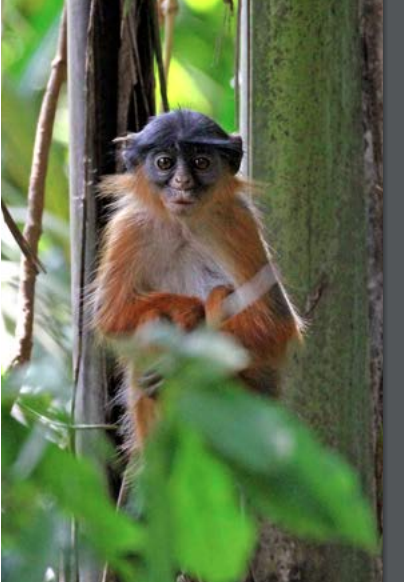Get updates and action alerts from Friends of Animals by joining our email list.
Get updates and action alerts from Friends of Animals by joining our email list.
Chimpanzee Rehabilitation Project extends help to Red Colobus Monkeys
The daily work of the Chimpanzee Rehabilitation Project (CRP) in the River Gambia National Park does not only focus on critically endan – gered chimpanzees—it concerns the protection of many wildlife species, including the critically endangered indigenous red colobus inhabiting both the islands and the mainland.
While visitors to the River Gambia National Park can take boat expeditions through the river and estuaries to get a view of chimpanzees, baboons, hippos, crocodiles, manatees, and more than 240 species of birds, red colobus monkeys scamper around the mainland campsite, providing a very rare up close and personal glimpse into their marvelous lives and behaviors.

This place, where you can explore a mosaic of gallery, woodland and savanna forests, and the opportunity it provides to see wildlife, is unlike any other.
Unfortunately, mainland red colobus populations are increasingly under threat by the alteration and destruction of their habitat. Located in the midst of their remaining habitat, the CRP camp has become a refuge for this very visible but rare primate, and that’s why CRP is increasing its efforts to protect the red colobus.
In the coming year, the CRP plans to take a more proactive role in protecting the mainland habitat in conjunction with its community development projects, which provide wells and gardens for village neighbors.
The striking red colobus, with its red or chestnut-brown limbs and black, slate-grey and dark brown head and shoulders, are mainly active during the day. Red colobus monkeys are herbivores who mainly eat leaves and are usually found in large groups of 20 to 80 individuals, although they split into smaller groups when foraging. They are extraordinarily adapted to their entirely vegetarian and widely varied diet.
They have special salivary glands, which are larger and produce more specialized saliva to help facilitate the breakdown of leaves before they even reach their digestive tract. The stomach of the red colobus is divided into chambers and is larger than those of other monkeys of a comparative size. This allows for longer digestion, so that most nutrients can be gleaned from the relatively low nutrient food. Interestingly, they are members of the group of primates called Old World monkeys and have non-prehensile tails, which means they can’t be used to cling onto branches in the way New World monkeys use their tails.
Contributions to Friends of Animals will help support the CRP’s efforts to protect these amazing creatures in conjunction with the local community, which is key to successful conservation work.
In addition to making a donation, please consider a visit to the Chimpanzee Rehabilitation Project in the River Gambia National Park. Activities include a variety of boat tours, hikes to different locations, visits to neighboring projects and simple relaxation. And you just might catch one of the most breathtaking sunrise vistas in The Gambia from the cliffs overhanging the River Gambia. Accommodations are designed to allow guests to appreciate the environment while ensuring their presence does not damage the wilderness. To make a donation, visit www.friendsofanimals.org. To plan a trip, visit the Chimpanzee Rehabilitation Project in The Gambia Facebook page or email baboonislands@gmail.com for more information.